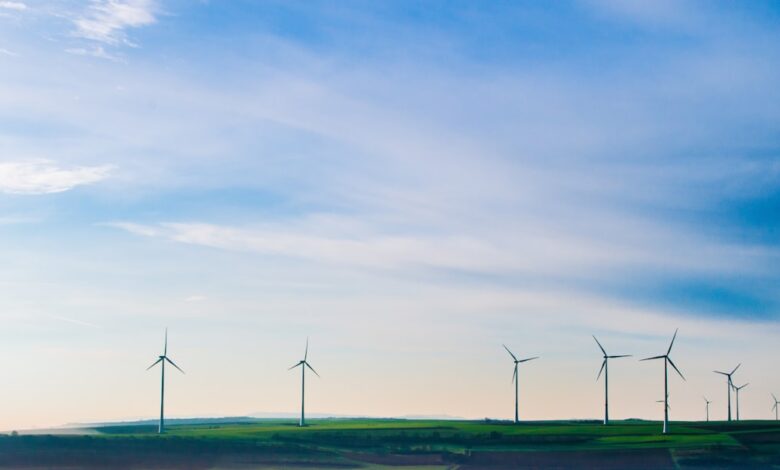Powering Tomorrow: The Role of Nuclear Energy in a Low-Carbon Future

As the world grapples with the urgent need to transition to low-carbon energy sources, nuclear energy emerges as a pivotal player in the quest for a sustainable future. With climate change posing unprecedented challenges, nations are increasingly turning to nuclear power not only for its ability to generate large amounts of electricity with minimal carbon emissions but also for the innovations that promise to reshape its role in the energy landscape. This article delves into the future of nuclear energy, exploring the advancements that are driving a nuclear renaissance, the policies and public perceptions that must be navigated to foster wider adoption, and the delicate balance between safety and sustainability in the pursuit of net-zero emissions. As we stand at a crossroads in energy production, understanding the complexities and potential of nuclear power is essential for charting a course toward a resilient, low-carbon world.
- 1. "Navigating the Nuclear Renaissance: Innovations Driving a Sustainable Energy Future"
- 2. "Policy and Public Perception: Overcoming Barriers to Nuclear Adoption in a Low-Carbon Era"
- 3. "Balancing Safety and Sustainability: The Role of Nuclear Energy in Achieving Net-Zero Goals"
1. "Navigating the Nuclear Renaissance: Innovations Driving a Sustainable Energy Future"
As the world grapples with the pressing need to reduce carbon emissions and mitigate climate change, the potential of nuclear energy is experiencing a significant renaissance. This revival is driven by a confluence of technological innovations, regulatory advancements, and a growing recognition of nuclear power as a reliable, low-carbon energy source. The future of nuclear energy is being shaped by several key innovations that promise to enhance safety, efficiency, and sustainability.
One of the most promising developments in the nuclear sector is the advent of small modular reactors (SMRs). These compact systems offer several advantages over traditional large-scale reactors, including reduced upfront capital costs, enhanced safety features, and the ability to be deployed in a wider variety of locations. SMRs can be constructed in factories and transported to sites, significantly shortening construction timelines and minimizing on-site risks. Their modular nature allows for incremental capacity additions, making them an attractive option for utilities seeking to expand their energy portfolios without committing to large-scale projects.
In parallel, advancements in advanced reactor designs, such as Generation IV reactors, are paving the way for even safer and more efficient nuclear power. These reactors incorporate innovative cooling systems and fuel cycles that minimize waste and enhance resource utilization. For instance, some designs utilize fast neutron reactors that can recycle spent fuel, significantly reducing the volume of nuclear waste and maximizing the use of available uranium resources. These technologies not only promise to make nuclear energy more sustainable but also address one of the most significant barriers to its broader acceptance: concerns over long-term waste management.
Moreover, the integration of digital technologies into nuclear operations is transforming the industry. Modern data analytics, artificial intelligence, and the Internet of Things (IoT) are being harnessed to optimize plant performance, enhance safety protocols, and improve maintenance practices. Predictive maintenance models can help anticipate equipment failures before they occur, reducing downtime and increasing the overall efficiency of nuclear facilities. Additionally, virtual reality and simulation technologies are being used for training purposes, ensuring that operators are well-prepared to handle complex systems and emergency situations.
Regulatory frameworks are also evolving to support the nuclear renaissance. Policymakers are beginning to recognize the importance of nuclear energy in achieving climate goals and are streamlining approval processes for new technologies. This shift is essential for fostering innovation and ensuring that the nuclear industry can keep pace with the rapidly changing energy landscape.
As nations seek to transition to a low-carbon future, the role of nuclear energy will be pivotal. By leveraging these innovations, the nuclear sector can not only meet the world's growing energy demands but also contribute significantly to global decarbonization efforts. The path forward is one of collaboration, investment, and a commitment to harnessing the full potential of nuclear technology in the pursuit of a sustainable energy future.
2. "Policy and Public Perception: Overcoming Barriers to Nuclear Adoption in a Low-Carbon Era"
The transition to a low-carbon world necessitates a multifaceted approach to energy generation, and nuclear power plays a pivotal role in this equation. However, the path toward greater nuclear adoption is fraught with challenges, primarily stemming from policy frameworks and public perception. To fully harness the benefits of nuclear energy, it is essential to address these barriers effectively.
Policy is a critical driver of energy choices. Governments must create supportive regulatory environments that facilitate the development and deployment of nuclear technology. This includes streamlining approval processes for new reactors, investing in research and development for advanced nuclear technologies, and establishing clear frameworks for waste management and decommissioning. By providing stable and predictable policies, governments can encourage private investment in nuclear energy, which is vital for scaling up infrastructure and innovation.
Public perception of nuclear energy is another significant barrier that needs to be addressed. Historical events, such as the accidents at Chernobyl and Fukushima, have left a lasting impact on public opinion, fostering a sense of mistrust and fear surrounding nuclear power. Education and transparent communication are essential in reshaping this narrative. Engaging with communities, providing accurate information about safety advancements, and highlighting the role of nuclear energy in mitigating climate change can help build public support.
Moreover, addressing misconceptions about the safety and environmental impact of nuclear energy is critical. The development of next-generation reactors, which promise enhanced safety features and reduced waste, should be communicated effectively to the public. Demonstrating the tangible benefits of nuclear energy—such as its ability to provide reliable, baseload power with minimal carbon emissions—can create a more favorable perception.
Collaboration between government, industry, and civil society is crucial in fostering a balanced dialogue about nuclear energy. Public forums, educational campaigns, and stakeholder engagement initiatives can help bridge the gap between policymakers and the communities they serve. By actively involving the public in discussions about the future of energy and the role of nuclear power, a more informed and constructive conversation can emerge.
Ultimately, overcoming the barriers to nuclear adoption in a low-carbon era requires a concerted effort to align policy with public sentiment. By addressing regulatory challenges and reshaping perceptions, nuclear energy can be positioned as a vital component of a sustainable and secure energy future.
3. "Balancing Safety and Sustainability: The Role of Nuclear Energy in Achieving Net-Zero Goals"
Nuclear energy plays a pivotal role in the transition towards a low-carbon future, particularly as nations strive to meet net-zero emissions targets. However, this potential is accompanied by the dual imperative of ensuring safety and enhancing sustainability. Striking a balance between these two critical dimensions is essential for the broader acceptance and integration of nuclear power into energy systems worldwide.
Safety remains paramount in the nuclear energy sector, shaped by historical events that have heightened public apprehension. The industry has made significant strides in improving the safety of nuclear reactors, incorporating advanced technologies and rigorous regulatory frameworks. Modern reactor designs, such as small modular reactors (SMRs) and Generation IV reactors, emphasize passive safety features that minimize the risk of accidents. These innovations not only enhance operational safety but also contribute to public confidence, which is vital for garnering support for nuclear energy expansion.
On the sustainability front, nuclear power is a low-carbon energy source that can provide a stable and reliable supply of electricity, complementing intermittent renewable sources like solar and wind. As countries grapple with the challenges of energy transition, nuclear energy's ability to operate continuously means it can effectively support grid stability and energy security. Furthermore, advancements in fuel cycle management, including recycling and reprocessing, can reduce waste and extend the lifecycle of nuclear fuel, aligning with broader sustainability objectives.
The integration of nuclear energy into a low-carbon future also necessitates a comprehensive approach that considers social and environmental impacts. Engaging with local communities and stakeholders is essential to address concerns about waste management, land use, and potential health risks. By fostering transparent dialogue and emphasizing the safety improvements and sustainability benefits of nuclear energy, policymakers can build a more robust public consensus.
In conclusion, the role of nuclear energy in achieving net-zero goals hinges on the successful balancing of safety and sustainability. By investing in technological advancements, enhancing regulatory frameworks, and promoting community engagement, nuclear power can emerge as a cornerstone of a resilient and low-carbon energy landscape. As the world seeks to navigate the complexities of climate change, nuclear energy offers a viable pathway to achieve both environmental and energy security objectives.
In conclusion, the future of nuclear energy in a low-carbon world holds significant promise as a cornerstone of sustainable energy strategies. As we navigate the nuclear renaissance, innovative technologies and advanced reactor designs are paving the way for safer, more efficient operations that can meet the increasing demand for clean energy. However, unlocking this potential requires a concerted effort to overcome policy hurdles and shift public perception, addressing concerns that have historically hindered nuclear adoption. By fostering open dialogues, enhancing transparency, and demonstrating the environmental benefits of nuclear power, stakeholders can build the necessary trust to integrate this energy source into broader climate strategies.
Moreover, as we strive to achieve net-zero goals, nuclear energy's role becomes even more critical. Its ability to provide reliable, baseload power complements intermittent renewable sources, ensuring a balanced and resilient energy grid. By prioritizing safety and sustainability, we can harness the full capabilities of nuclear technology as an essential player in the fight against climate change. Ultimately, embracing nuclear energy as part of a diversified energy portfolio will not only help mitigate greenhouse gas emissions but also secure a cleaner, more sustainable future for generations to come. The time to act is now—by investing in nuclear advancements and fostering supportive policies, we can turn the vision of a low-carbon world into a reality.





